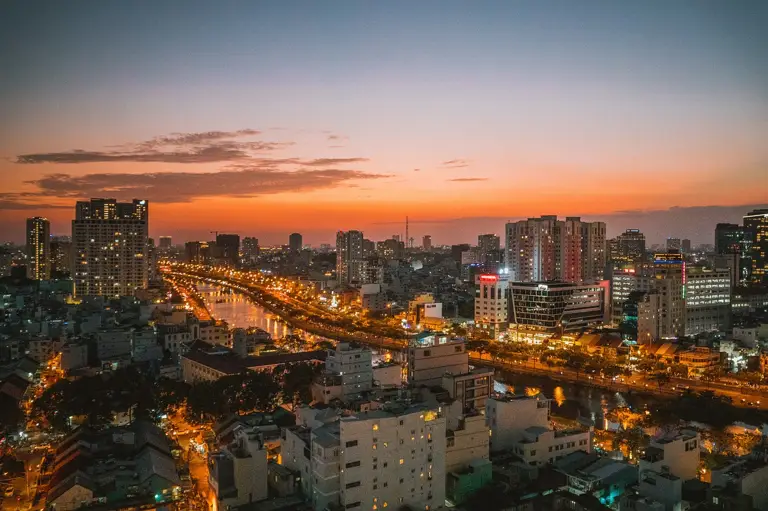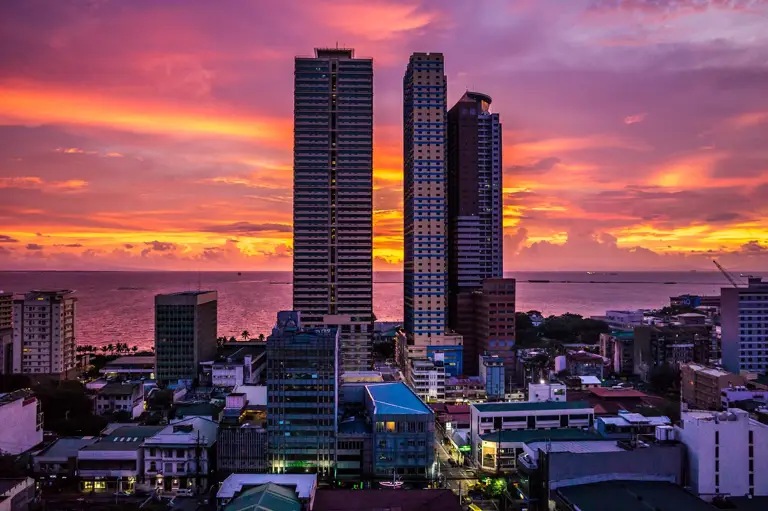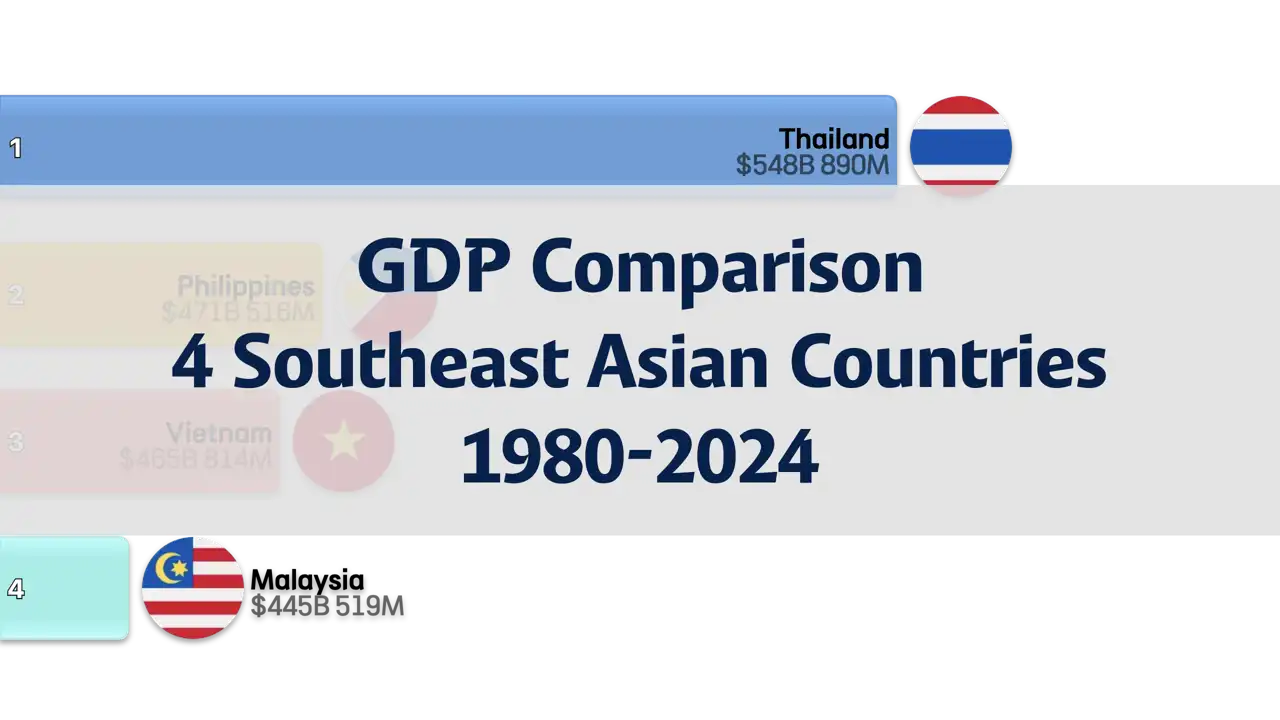
How Do Southeast Asia's Top Economies Stack Up in 2024? A Look at GDP Figures for Thailand, the Philippines, Vietnam, and Malaysia
- ASUMUP
- National Rankings / Southeast Asia
- August 6, 2024
Southeast Asia is a region of dynamic growth, with several countries emerging as key players in the global economy. As we look at the GDP figures for 2024, it's clear that the region's largest economies are on a fast track to development. In this post, we'll compare the GDPs of four major Southeast Asian countries: Thailand, the Philippines, Vietnam, and Malaysia. These nations have shown remarkable resilience and adaptability, but how do they compare against each other? Let's dive into the numbers and see what the economic landscape looks like for each of these countries.
Southeast Asia's GDP Showdown
- 1st Thailand - $548.9 billion
- 2nd Philippines - $471.5 billion
- 3rd Vietnam - $465.8 billion
- 4th Malaysia - $445.5 billion
4th Malaysia - $445.5 billion
Malaysia rounds out the comparison with a GDP of $445.5 billion. Known for its well-developed infrastructure and strong financial services sector, Malaysia has a diversified economy with significant contributions from manufacturing, oil and gas, and palm oil production. The country has also been a leader in the adoption of digital technologies, which has further boosted its economic profile. However, Malaysia faces challenges such as political uncertainty and the need to reduce dependence on natural resources. Despite these challenges, Malaysia remains an important economic player in Southeast Asia, with a steady growth trajectory.
3rd Vietnam - $465.8 billion
Vietnam closely follows the Philippines with a GDP of $465.8 billion. Over the past few decades, Vietnam has transformed into one of the fastest-growing economies in Southeast Asia, thanks to its shift from a centrally planned economy to a market-oriented one. Key sectors such as manufacturing, electronics, and agriculture have been the backbone of Vietnam's economic success. The country has also attracted significant foreign direct investment (FDI), particularly from tech giants. Despite its impressive growth, Vietnam still needs to address issues like labor market imbalances and environmental sustainability to ensure long-term economic stability.
2nd Philippines - $471.5 billion
The Philippines comes in second with a GDP of $471.5 billion. The country's economy is driven by a strong service sector, particularly in business process outsourcing (BPO) and remittances from overseas workers. The Philippines has also seen rapid urbanization and a growing middle class, which have spurred domestic consumption. However, the economy faces challenges such as infrastructure deficits and the impacts of natural disasters. Nevertheless, the Philippines continues to exhibit strong economic growth, positioning itself as a significant player in the Southeast Asian region.
1st Thailand - $548.9 billion
Thailand leads the pack among these Southeast Asian nations with a GDP of $548.9 billion in 2024. Known for its diverse economy, which includes tourism, agriculture, and manufacturing, Thailand has managed to maintain steady growth. The country's robust infrastructure and strategic location in the region have made it a hub for trade and investment. However, Thailand still faces challenges such as political instability and the need for economic diversification. Despite these hurdles, it remains the largest economy in this comparison, reflecting its ongoing economic resilience.
Other Posts in the National Rankings / Southeast Asia
Categories
- National Rankings(43)
- Science & Technology(1)
- Sports(24)
- Economy(30)
- Society(12)
- Culture(7)
Recent Posts
![Bayern Spent HOW MUCH on Harry Kane?! Ranking Their Top 10 Biggest Signings Ever]() A deep dive into Bayern Munich's ten most expensive transfers, exploring how the club's spending strategy has evolved to chase European glory.
A deep dive into Bayern Munich's ten most expensive transfers, exploring how the club's spending strategy has evolved to chase European glory.![Arsenal's Record-Shattering Spree: From a €116M Gamble to a Flop, Who Was Worth the Cash?]() A deep dive into Arsenal's top 10 most expensive signings, analyzing the successes, the failures, and the massive fees that have defined the club's modern transfer strategy.
A deep dive into Arsenal's top 10 most expensive signings, analyzing the successes, the failures, and the massive fees that have defined the club's modern transfer strategy.![Chelsea Cashes In BIG TIME! Who Really Won the 25/26 Summer Transfer Window Money Game?]() A deep dive into the top 10 clubs that made the most money from player sales during the wild 25/26 summer transfer window.
A deep dive into the top 10 clubs that made the most money from player sales during the wild 25/26 summer transfer window.![Liverpool's Record-Breaking €483M Spree! Did They Just Buy the Premier League Title?]() A deep dive into the 25/26 summer transfer window reveals Liverpool's record-breaking spending spree as Premier League clubs continue to dominate the market.
A deep dive into the 25/26 summer transfer window reveals Liverpool's record-breaking spending spree as Premier League clubs continue to dominate the market.![You Won't Believe How Much a Loaf of Bread Costs in These Countries! (Spoiler: It's INSANE)]() This post explores the top 10 countries with the most expensive bread, revealing how factors like import reliance and tourism dramatically inflate the cost of this basic staple.
This post explores the top 10 countries with the most expensive bread, revealing how factors like import reliance and tourism dramatically inflate the cost of this basic staple.










